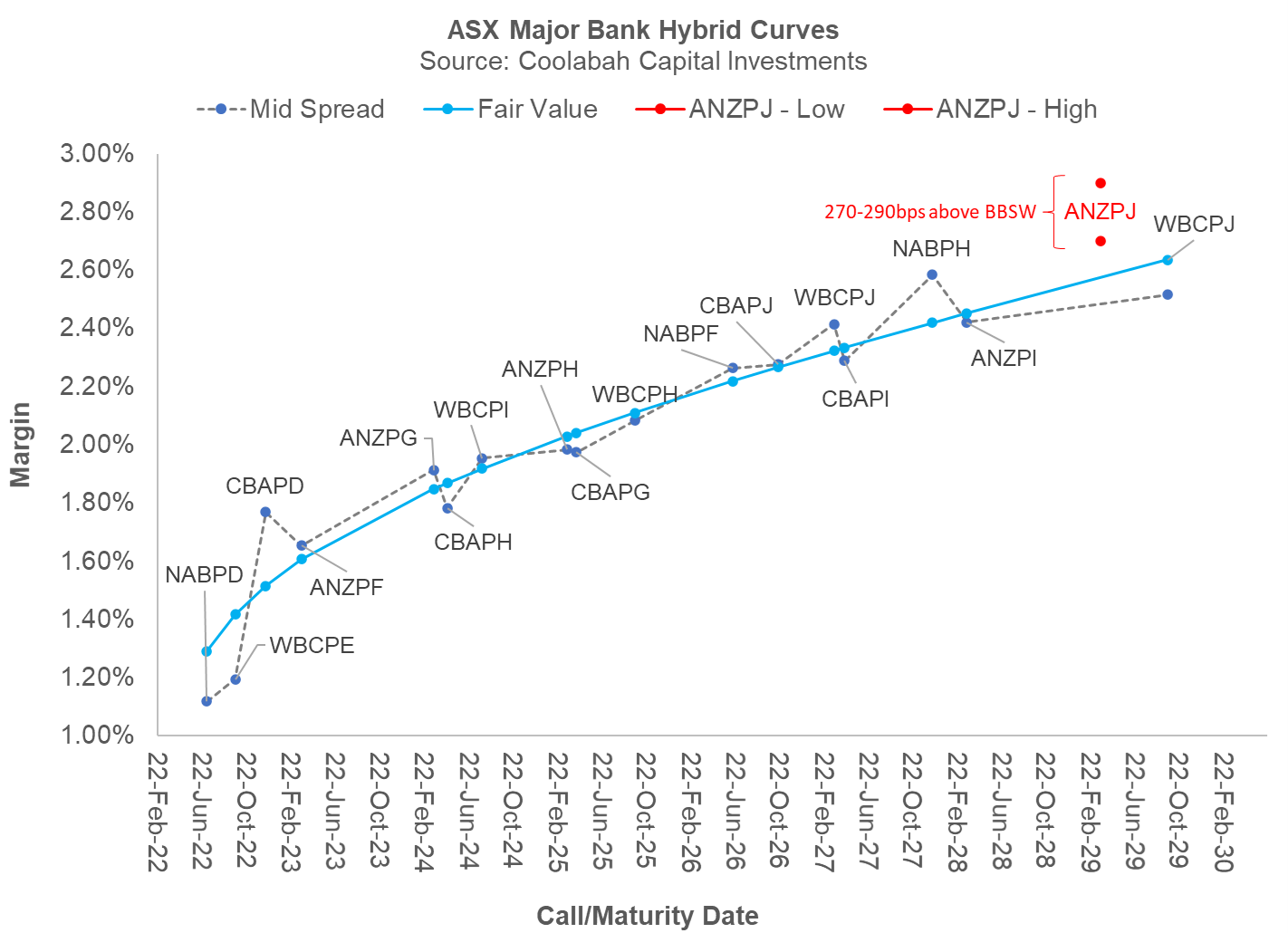New 2.78% pa ANZ hybrid (ANZPJ) looks to be paying a 15-22bps new issue concession
So ANZ have launched a new 7 year hybrid (ASX: ANZPJ) to replace their maturing $1.61bn existing hybrid (ASX: ANZPE), which it has announced will be repaid on 24 March 2022. Based on current secondary hybrid curves, the new ANZ hybrid looks to be paying about 15-22 basis points (bps) of extra annual income (ie, a new issue concession).
Standard & Poor's applies an investment-grade, BBB- rating to major bank hybrids, although we are projecting that this could increase to BBB flat as a result of S&P boosting Australia's Banking Industry Country Risk Assessment (BICRA) score.
It's worth noting that this is a floating-rate, rather than fixed-rate, security that pays a fixed margin above the quarterly bank bill swap rate (BBSW). As the RBA increases its cash rate in 2022 and 2023, investors will receive a higher total income distribution as BBSW increases (BBSW normally sits a little above the RBA cash rate). Another way of describing floating-rate hybrids is that they have very low interest rate duration risk (ie, you are not betting on rates rising or falling).
The deal has a proposed income distribution range of 270-290bps (or 2.7% to 2.9%) fully franked above BBSW, which equates to a running yield of about 2.78% annually. This is 15-22bps above where the secondary ASX curves were implying a new 7 year deal would have to come (see chart below).

Prior to the deal launching, we had fair value for a new 7 year major bank hybrid sitting at 248bps above BBSW, or 22bps inside the low end of ANZ's proposed 270-290bps range. We have other models based on the ASX curve that imply a fair value of about 255bps, pointing to a circa 15bps concession.
While this seems attractive, it is worth noting that hybrid spreads have been historically quite tight, especially into the end of 2021 when our 5-year curve got to as low as 207bps (in 2021 we consistently forecast that spreads would move towards 200bps by 31 December).
The 5-year curve has since increased to a much more palatable 233bps, although this is tight of the post-GFC trading range around ~300bps. Having said that, higher-ranking debt securities, such as 5-year major bank senior and Tier 2 bonds, are both also trading tight of their post-GFC averages.
Also note that there is another CBA hybrid maturity that is due to be refinanced/replaced on 31 March this year, which is the $1.64 billion CBAPF. One would expect that deal to be announced in late February or early March with similar terms to ANZ's new security.
In terms of the immediately adjacent securities on the ASX curve, ANZPI is one year shorter than ANZPJ and was trading with a mid of 242bps. Since the start of the year it has traded between 235-250bps.
WBCPK is the longest rated hybrid (6 months longer than ANZPJ) and the most recent issue. It has been trading at a mid of 252bps with a recent range between 242-256bps this year.
Yet both ANZPI and WBCPK trade tight on the curve (see above). NABPH (1.25 years shorter than ANZPJ) has been the widest major bank line at 262bps. This has historically traded above the fair value curve in a range of 240-262bps this year.
There are a few other interesting developments with the new ANZPJ deal. As a result of the implementation of ASIC's new Design & Distribution Obligation laws, this 2.78% pa hybrid is only available to:
- wholesale/sophisticated investors, or
- retail investors who have received personal advice from their financial planner.
There will also be no general offer to ANZ securityholders.
All of this suggests the total deal size should be a bit smaller than previous hybrid transactions. And we are forecasting that the major banks will shift some of their future supply to the institutional unlisted over-the-counter market, as NAB has repeatedly done.
If non-advised retail investors want to buy ANZPJ, they will either have to wait until it lists on the ASX, or allocate indirectly via an exchange-traded fund that can buy the deal in primary.
In the bank capital structure, hybrids rank ahead of ordinary shares but below Tier 2 bonds. In March 2020, the Solactive major bank hybrid index fell about 4.7%, which while more than government bonds was substantially less than high-yield bonds (down 13.5%) and bank equities, which fell 25%-35%.
Hybrids have many risks, including the risk of being automatically converted into ANZ ordinary shares or written-off, and you should read the PDS and consult an adviser to better understand these issues.
Access Coolabah's intellectual edge
With the biggest team in investment-grade Australian fixed-income and over $7 billion in FUM, Coolabah Capital Investments publishes unique insights and research on markets and macroeconomics from around the world overlaid leveraging its 14 analysts and 5 portfolio managers. Click the ‘CONTACT’ button below to get in touch.
1 topic

